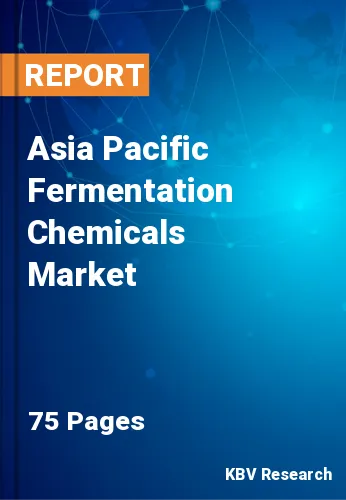The Asia Pacific Fermentation Chemicals Market would witness market growth of 6.6% CAGR during the forecast period (2019-2025). The China market dominated the Asia Pacific Industrial Market by Region in 2018, and would continue to be a dominant market till 2025. The Japan market is expected to witness a CAGR of 7% during (2019 - 2025).
Fermentation, a metabolic procedure, produces chemical alterations within organic substrates by the activities of enzymes. It is also explained as the process of energy extraction from carbohydrates in absence of oxygen. With the perspective related to the food processing sector, it is also defined as a process that brings the desired alteration in a beverage or food with the actions of specific microorganisms in a controlled environment or conditions.
While there are a number of chemicals used for the intended fermentation however, most commonly used products for fermentations are Alcohol, Enzymes, and Organic Acids.
Ethanol fermentation, also known as alcohol fermentation, is a biological procedure to convert various sugar forms such as sucrose, fructose and glucose into cellular energy resulting in the production of ethanol and carbon dioxide as by products. Mostly, berries, sugar cane, grapes, corn, wheat, rice, honey, potatoes, hops, barley and other plant materials are used for fermentation. Fermentation has its wide variety of commercial applications mostly in the food processing industry. A large variety of bacteria are utilized for the production of pickles, olives and sauerkraut from the raw olives, cucumbers, and cabbage, respectively. Alcoholic fermentation is the foundation for the manufacturing of alcoholic beverages like beer and wine. In few cases, many antibiotics and other drugs are prepared by using fermentation process. For instance, an important drug cortisone is also attained by the fermentation of diosgenin, a plant steroid.
At the beginning of 2017, China Solid Waste and Chemicals Management Centre under the Ministry of Environmental Protection (MEPSCC) initiated the revision work to the Measures on the Environmental Administration of New Chemical Substance in China. The revisions to the Measures lead to the further improvements of the measures for the environmental administration of new chemical substances, which is of great significance to the prevention of environmental and health risks of new chemical substances.
On 28 December 2017, theMinistry of Environmental Protection (MEP) in China published the Prioritized List of Substances to be Subject to Control (1st Batch). This list contain a total of 36 chemicals, spanning a broad range of industries, including petrochemicalindustry, coking industry, agrochemical industry, dye industry and electroplating industry. To reduce theimpact of these chemicals on human health and the environment, risk management measures should be carried out.
China further included 31 “new chemicals“ to its database of “existing chemicals“ on 8 March 2016, effectively changing regulatory requirements for handling listed chemicals. These 31 substances are currently part of country’s inventory of standing chemicals, listing more than 45,000 chemicals. Based on the designation and harm, importers and manufacturers of registered chemicals must conform with pollutant release and reporting necessities, emergency response actions, monitoring and further controls. China’s most stringent chemical limitations relate to chemicals utilized in petrochemical processing, chemical fiber manufacturing, pharmaceutical manufacturing, and bulk industrial chemicals manufacturing.
In Japan, the Law on the Evaluation of Chemical Substances and Regulation of respective Manufactures, etc., or Chemical Substances Control Law (CSCL), controls the manufacture, import and usage of chemicals in the country. The CSCL includes necessities for advance notification, assessment of risk involved, usage restriction and information of existing and new chemicals, hazard communication and grouping of general industrial chemicals.
The report highlights the adoption of Fermentation Chemicals in Asia Pacific. Based on Application, the market is segmented into Industrial, Plastics & Fibers, Food and Beverages, Pharmaceutical and Nutritional and Other Applications. Based on Product, the market is segmented into Alcohols, Organic Acid, Enzymes and Other Products. The report also covers geographical segmentation of Fermentation Chemicals market. The countries included in the report are China, Japan, India, South Korea, Singapore, Malaysia and Rest of Asia Pacific.
The major market players expanding their reach in the Asia Pacific Fermentation Chemicals market are Novozymes A/S, Koch Industries, Inc. (Invista BV), The Dow Chemical Company, BASF SE, Archer Daniels Midland Company, Cargill Corporation, Chr. Hansen Holding A/S, Koninklijke DSM N.V, Ajinomoto Co. Inc. and Evonik Industries AG (RAG-Stiftung).
Market Segmentation:
By Application
By Product
By Country
Companies Profiled
Our team of dedicated experts can provide you with attractive expansion opportunities for your business.

